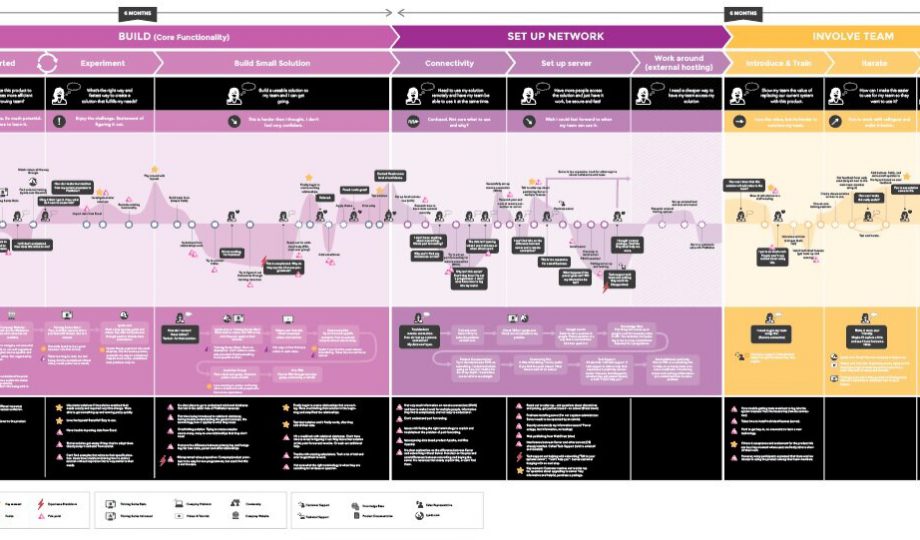As designers, we are often thrust into projects on topics and within industries that we know next to nothing about. Part of our job is to dive deep into a new subject and learn as much as we can quickly in order to ramp up and be able to design better experiences. Exploratory research in the form of in-depth interviews, diary studies, and workshops is one way to do that, but there is often great value in conducting secondary research, too! This means looking into research that’s already been conducted and can be applied to your new project. Desk research is the best way to orient ourselves to the industry and context we will be working within. Today’s post will tell you exactly how to conduct desk research in UX and service design.
Back in Part One of our series on desk research, how to use desk research in UX and service design?, we set a solid foundation for what desk research is, when to use it in the design process, and the six main types of desk research, (document review, as-is data sources, web audits/google analytics device, literature review, jurisdictional scans, and comparative analysis) used in UX and service design. In this post, we are taking things a step further and looking at exactly how to conduct desk research used most often in a UX or design research project.
We’ll cover…
- The desk research planning process
- How to conduct a literature review and trend analysis in UX and service design?
- Deep dive: running a comparative analysis in UX
- Conducting a SWOT analysis
The desk research planning process
The best way to tackle desk research is to be prepared with a solid plan! Here are five key steps to starting the desk research planning process:
- Talk to your stakeholders. You want to go into desk research with a solid understanding of what the company or organization already knows about the topic at hand, and one of the best ways to do that is by talking to stakeholders and executives! It’s important to involve stakeholders early and wherever possible, so book their time in advance and keep in frequent contact. When you get the chance to sit down with them, get granular with your questions and listen carefully to their answers. It’s likely you’ll identify more problem areas you weren’t aware of, and develop more questions. Remember, the majority of what you’re learning from these stakeholder conversations comes from their own unique understanding and perspective, which isn’t always the entire picture. The great thing about desk research is it gives you the opportunity to cleanse your palate and get to the facts!
- Define the goal or questions at hand. What problem are we trying to solve? What information are you trying to find? What would be most helpful to the product or service you are designing?
- Determine which types of desk research you’ll use. Which methods will be most effective for your research question and project goals? There are many different types of desk research you can dig into, so depending on what information you’re looking for, you’ll want to consider both internal and external desk research. Internal research is usually the starting point, and will tell you what’s going on within your organization through data that’s readily available to you. For more info on internal vs. external research and an entire breakdown of the six types of desk research, check out part one of this blog series!
- Make a list of potential topics that you want to dig into. Think of everything that impacts this project! Stakeholders will be of great help here. There will be one obvious topic, which is what your project is on, but you’ll need to branch out from there and think about other subjects that might impact your main topic. A great way to do this is by creating a mind map – start with your main topic in the centre and work outwards. For example, if travel is at the centre of your mind map, moving outward you might write subtopics like domestic travel, international travel, the economy, illness, climate change, etc.
- Jot down a rough plan! Once you’ve set some goals, create a rough plan. Write down everything you’ve found out so far, the topics you want to uncover through the literature, how you’ll use the information you uncover, etc.
How to conduct a literature review and trend analysis in UX and service design?
Now that you have spoken with stakeholders and executives, defined goals, solidified the questions you’re looking to answer and made a rough plan, it’s time to get into actually conducting the desk research. A literature review can be about anything, but a trend analysis means you’re looking in the literature for trends about the topic at hand. You’ll want to look for what’s going on right now, what’s a few years away, and what might happen in the future. Do this by adding search terms like, “topic + travel + 2025” or “2030” (aka travel trends 2025).
A modern literature review often starts with a google search. Look for online journal articles, reputable online blogs and articles, research reports, and white papers. For a UX or service design project, we typically look for 20-30 credible sources.
Note: A critical piece of desk research is choosing your sources – where will you extract your information from, both internally and externally? Your sources will help you to expand and dive deeper into the information you uncovered during your preparatory phase. Choose sources that are highly credible, reputable, and top sources. How can you know if you’ve found a credible source? There are a handful of frameworks, like The 5 W Questions, a SMART Check, and CRAAP Test, which you can use to critically assess your selected sources.
Let’s get into it…
- Start with broad search terms based on key topics. Type these broad terms into Google and start by clicking on the top-level links that are being served to you. Read through them and learn more about each of these topics, and keep the links to the first articles you stumble upon. They might not be the articles you end up sourcing in the end, but they’ll help by giving you more keywords to search for! You’ll notice patterns as trends emerge in the keywords you’re searching for, allowing you to discover more specific trends and subtopics.
- Save links and cut snippets of text. Use an excel spreadsheet to keep track of your sources as you go. Copy paste snippets of text that are interesting and add them to a cell in your spreadsheet, make sure you provide a link back to the original article inside the cell – otherwise things can get a little messy! This will help you with your data analysis later on.
- Identify subtopics/themes appearing throughout the literature and dig further. As you go through your sources and highlight common themes that are appearing, look out for any trends that may impact the direction of your product, business, or service, in both the short and long term. We recommend finding about five sources per subtopic.
- For example, if you’re reading an article titled, “Top 10 Trends in Travel,” you might notice they’re talking about climate change, technology, safety and cleanliness, etc. Once you’ve read a few articles and these themes continually overlap, they become your subtopics. You’ll then try to get five credible articles around “climate change and travel” that will help support your topic!
- Create summaries per subtopic. Typically, once you uncover a few themes that would be relevant to your project, write up a few descriptive paragraphs summarizing each theme and provide links to references.
- Draw connections and inferences. As you start to summarize your themes, you’ll be able to draw connections in the literature about how that insight may impact your product, service, or organization. These insights are most important –it’s a major reason for conducting desk research in the first place.
- Draft a report. While a report isn’t always required, we recommend at least putting together a summary package with highlights and links to your chosen sources! If for some reason another team member hops on your project or you need to pivot, whoever is coming in isn’t starting from scratch.
Deep dive: running a comparative analysis in UX
In addition to conducting a literature review, a comparative analysis is particularly useful in UX-specific projects. A comparative analysis should be performed early on in the UX design process as it is useful for understanding the product, mapping out the existing marketplace, and discovering potential threats and opportunities to the product/business. It involves comparing and evaluating the current products or services in the market, and is particularly helpful in UX/UI projects when you want to understand where your product will fit in the market, how it differs from the competition and any gaps or areas of opportunity that may be untapped. The value of a competitive analysis is that it can bring the design team a lot of inspiration, it can prove or disprove the value of your product/service, and help your team to find ways to differentiate your service further. It can include things like a simple feature list comparison between the various applications/products in the same space (like Trivago, Hotels.com and HotWire.) It may also include documenting detailed user flows by grabbing screenshots.
If there are several products/services being looked into, you can create a spreadsheet to compare all the different experiences. Looking into your competition can also involve creating a dummy account on their website to capture the experience, or testing out their product and documenting your findings, capturing screenshots and making screen recordings of your interaction(s) with competitor experiences in order to compare them against several different criteria most beneficial to your users. The criteria may include, but are not limited to:
- Look (UI design) and feel (UX design)
- User reviews (both good and bad!)
- Data entry requirements
- Accessibility compliance
- Technology constraints
- Ideal user paths/journeys
- Number of clicks
- Load time
- Ease of use, features, friction, functionality, and flow.
SWOT analysis
A great way to evaluate a company’s competitive and strategic position is by conducting a SWOT analysis. “A SWOT analysis is designed to facilitate a realistic, fact-based, data-driven look at the strengths and weaknesses of an organization, initiatives, or within its industry.” –Investopedia. By breaking down a company’s Strengths, Weaknesses, Opportunities, and Threats, you can make inferences based on what you learn and see, and determine how this could impact your client. Is this an opportunity, or is it a threat to look out for? The information you’ve learned from external literature reviews and your comparative analysis would inform the opportunities and threats piece of the SWOT analysis, whereas the strengths and weaknesses portion would be gathered through stakeholder workshops and internal desk research (such as previous research reports and presentations).
For example, how might the climate crisis affect the travel and tourism industry? Tourism and travel are massive generators of income, but also contribute greatly to the climate crisis, which is negatively impacting many popular travel destinations. However, if travel hotspots lose tourism numbers because of the climate crisis, their local economies suffer. This makes climate change a threat to the travel industry as it impacts people’s abilities to travel and the destination’s ability to host tourists.
We hope this post helped you understand more about actually conducting desk research for your next UX or design research project. The best way to approach desk research is by being “bright-eyed and bushy-tailed.” Always go in with a beginner’s mindset, be curious, and absorb as much information as you can.





